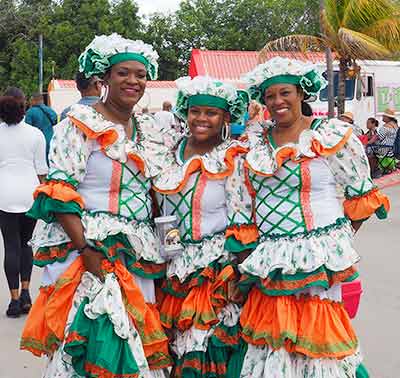The island’s melting pot has a unique culture.
The Bonairean culture is reflected in the faces of her people. Its origins are as varied as are the ethnic roots of the 21,000 residents. The real Bonairean culture is based on traditions that go back many generations. Traditions are chronicled in the songs and dances that are performed during holidays and festivals. Also, It is also based on strong family ties and general respect for nature, and an understanding of an environment that originally was foreign to those first settlers and slaves that were forced to work the inhospitable, arid land.
Those early days of slavery conditioned the people to be strong in the face of adversity. It was during this time that the spirit of the people began to develop, and they made up songs, invented dances, and began to sing in the old African Tradition. As a result, these songs and dances evolved into festivals and have survived to become an important part of life and culture on Bonaire.
Cultural dances.
The dances of the Simadan and the Bari are the best known. The traditional Waltz, Mazurka, the Polka, and the local “Baile di Sinta” (ribbon dance) were performed. Additionally, the Rumba, the Carioca, and Merengue dances came from other islands. American Jazz also influenced the local traditions of song and dance. Along with an eclectic assortment of homemade musical instruments, those early performers set the stage for a rich, local tradition that continues on to this very day.
Cultural events throughout the year.
The calendar of events will alert visitors to those that are taking place during their particular vacation period. The period from January 1-6 is the Maskarada. The Simadan, the Spring Harvest Festival, occurs from the end of February until the end of April. Additionally, the summer months celebrate Dia di San Juan and Dia di San Pedro with crioyo music and fire-jumping! Bari runs from the end of October to the end of December.
Dia di Rincon (Rincon Day), an annual celebration of culture.
Many of the festivals are regional. It may be strange that an island this small has regional differences, but there are some subtle and not-so-subtle differences from neighborhood to neighborhood. The Village of Rincon is perhaps more apt to celebrate all the holidays in grand style, while the village of North Salina devotes a lot of energy to Maskarada. The best example of strong cultural ties is during Dia Di Rincon (Rincon Day). Thousands of participants come from all over the Dutch Caribbean islands to celebrate.




Bonaire Day is celebrated each year on September 6th.
Bonaire’s Flag Day, Dia di Boneiru, is celebrated every year on September 6th. Bonaire may be a small island, but it has huge national pride. Also, the Annual Blessing of the Fishing Fleet is usually held on a weekend in September as well.
The cultural tradition continues to be influenced to this day. Visitors may just as well enjoy a Mariachi band or a local group performing at the same venue. Some of the most beautiful music you will hear may be a Mozart or Vivaldi piece played with an Antillean beat.







